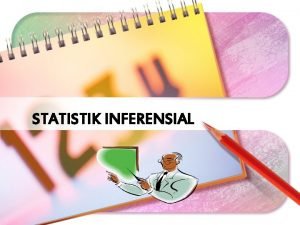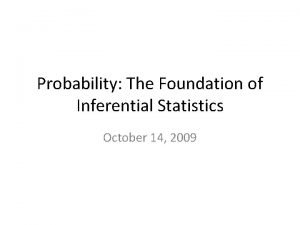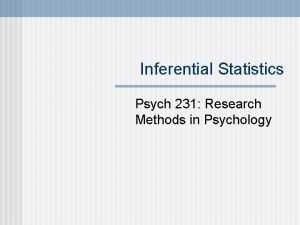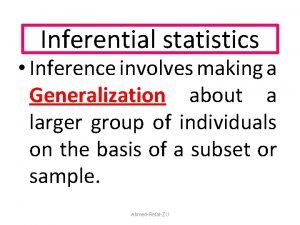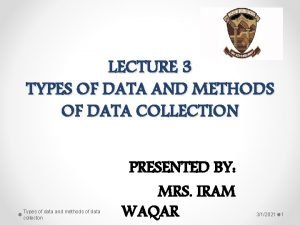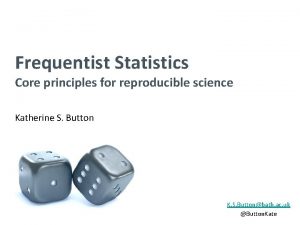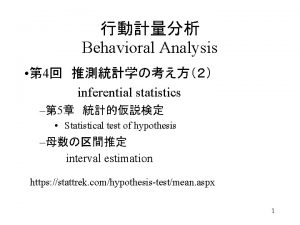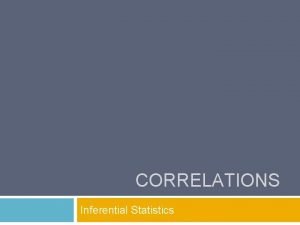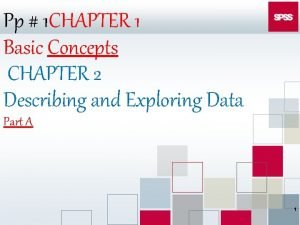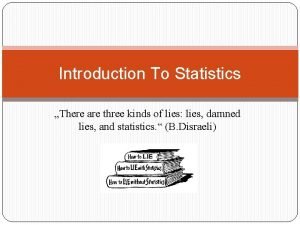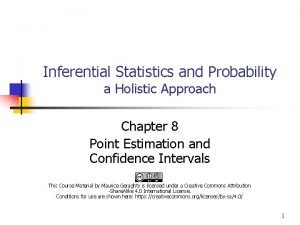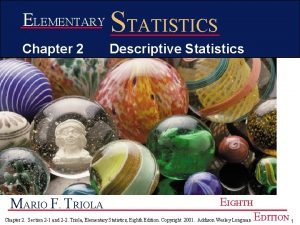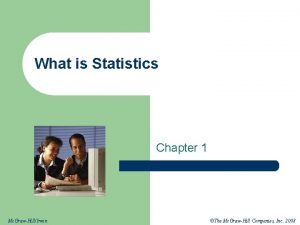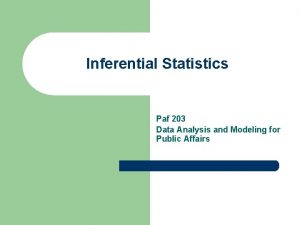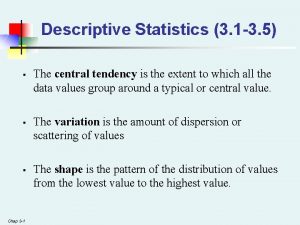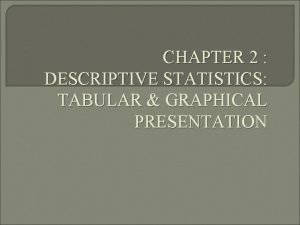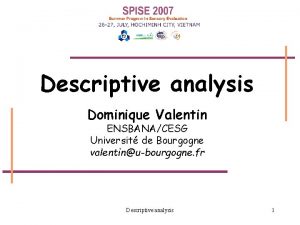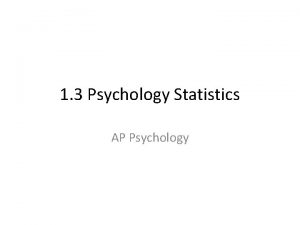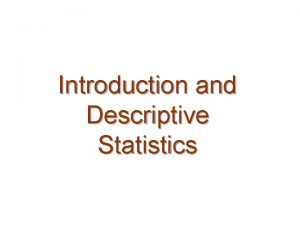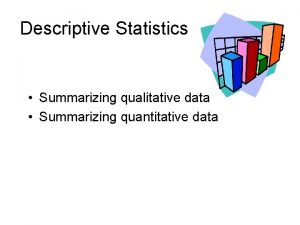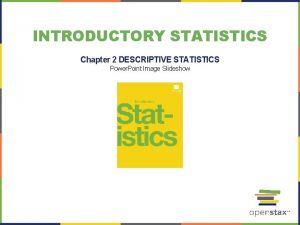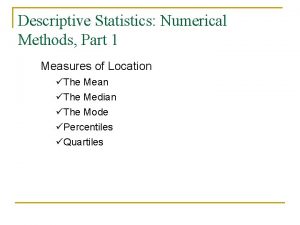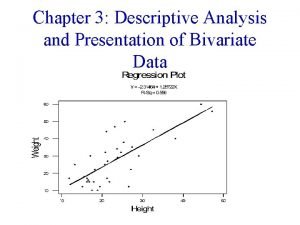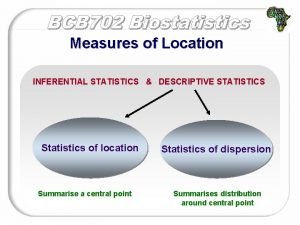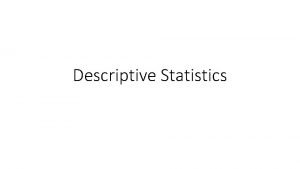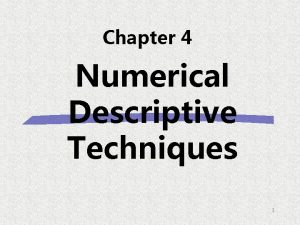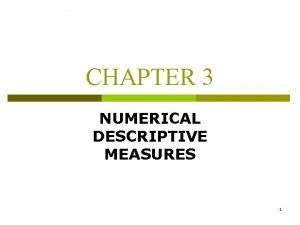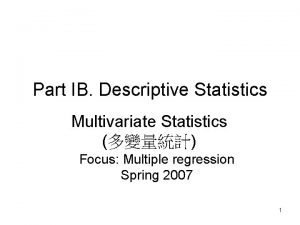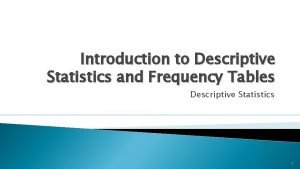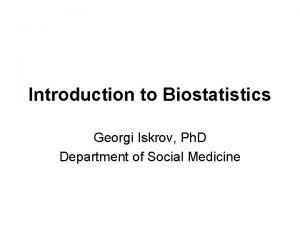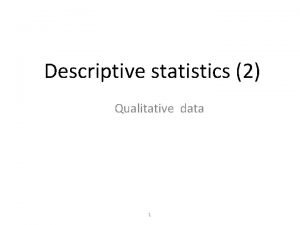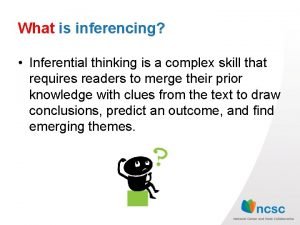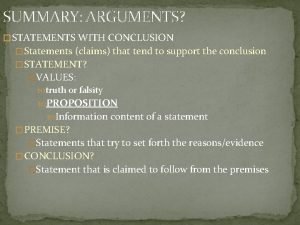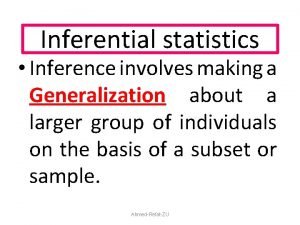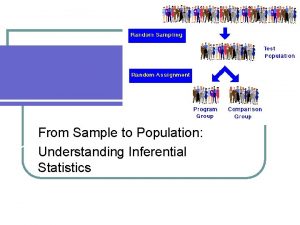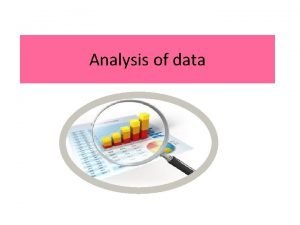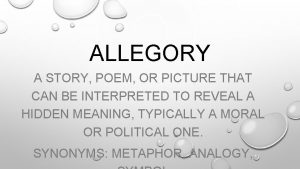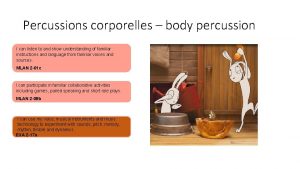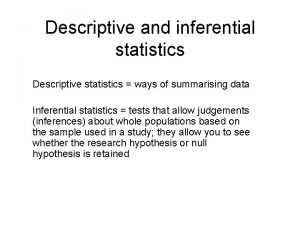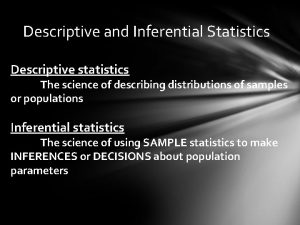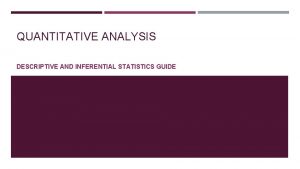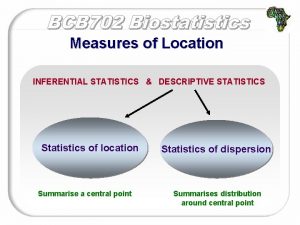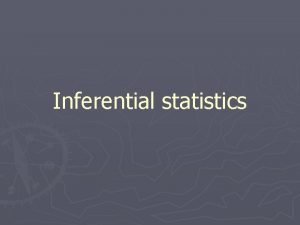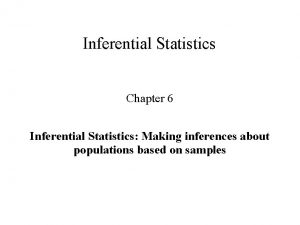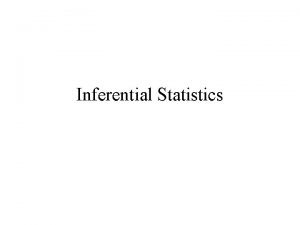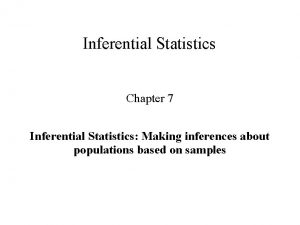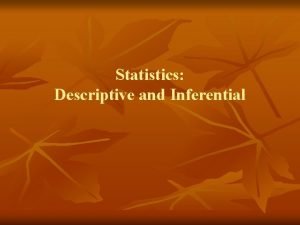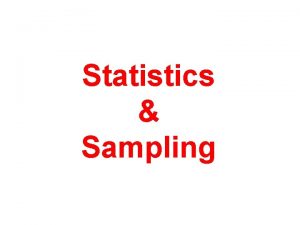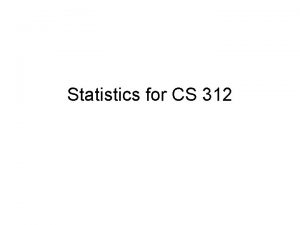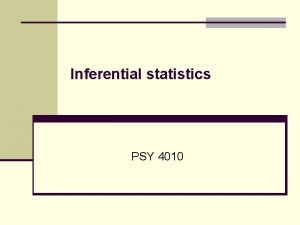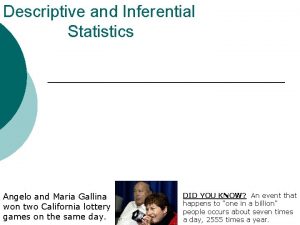Descriptive Statistics and Inferential Statistics A Picture Can








































































- Slides: 72

Descriptive Statistics and Inferential Statistics A Picture Can Be Worth a Thousand Words

Frequency Distributions Large amounts of information can be neatly organized and summarized Graphs can show entire patterns of scores very clearly The horizontal line is called the abscissa The vertical line is called the ordinate

Frequency Distribution Histogram: Graph of a frequency distribution in which the number of scores falling in each class represented by vertical bars Frequency polygon: Graph of a frequency distribution in which scores falling in each class represented by points on a line

Scores Graphed on a Histogram for Obedience to order to give shocks

Frequency Histogram for accuracy of taste: Which is abscissa?

Opiate Deaths by Age: Which is the Ordinate?

How Number in a Group Influences our Level of Conformity

Studies Want to Compare Groups: Average Score on Memory Test Use Measures of Central Tendency Mean: average score of each group Median: middle score of each group Mode: most frequent score

Measures of Variability Crucial How spread out are the scores in each group Range: difference between highest and lowest score Standard Deviation: how much does the typical score differ from the mean SD is the important statistic in most research studies

Standard Deviation When scores are widely spread, the standard deviation number gets larger When the scores are close together, the standard deviation score gets smaller Scores on different tests are converted by using standard deviations

Standardizing Scores From Different Tests Subtract mean from score and divide by the standard deviation for the group—now a Z-score Susan had a score of 110 in a class with a mean of 100 and a standard deviation of 10 Her z-score is what?

Turning Scores on Different Tests into Standard Scores Susan’s score on the original test was 110. In order to compare her performance to scores on other tests, her score was turned into a standard or z-score Her score was subtracted from the mean of 100, resulting in 10 10 was divided by the standard deviation of 10, resulting in?

Z-scores allow researchers to compare scores from different tests Susan’s standard or z-score is +1 Now John took a different memory test and received a score of 118. Why can’t compare John’s score to Susan’s original score of 110?

Importance of Standard Scores John’s score of 118 on one test can be compared to Susan’s score of 110 on a different score IF both scores are turned into standard or z-scores John’s score came from a class having a mean of 100 and a standard deviation of 18. What is his z-score?

Both John and Susan have the equivalent Standard Scores John: mean of 100 subtracted from his score of 118 is 18. Divided by the standard deviation of 18 provides the z-score of +1 Now we know that Susan and John scores are equivalent. Compared to other students, each was an equal distance above average.

Normal Curve When chance events are recorded, some outcomes have a high probability and occur very often Other events have a low probability and occur rarely Distributions resembles a normal curve

Normal Curve Bell-shaped, with large number of scores in the middle, with very few extremely high and low scores

Psychological Traits Follow the Bell Curve Measurements of height, memory span and intelligence are distributed along a normal curve Most people have “average” height, memory ability and intelligence Fewer people found at the extremes

Standard Deviation and the Normal Curve Standard deviation measures the proportion of curve above and below the mean 68 percent of all cases fall between one standard deviation above and below the mean

The Real Extremes! 9 percent of all cases fall between 2 standard deviations above and below the mean 99 percent of all cases fall between 3 standard deviations of the mean

Show the Percentages relative to Standard Deviations

Relationship between standard deviations and the normal curve

Standard scores relationship to the Normal Curve Z-scores of either – or + 3 are very extreme— 99. 9 or 00. 1 Z-scores of – or + 2 are also extreme: 97. 7 or 02. 3 Z-scores of plus or minus 1 are 84 or 16

Why need statistics? Results of psychological studies often expressed as numbers These numbers need to be summarized and interpreted to have any meaning Summarizing numbers with graphs makes it easier to see patterns

Graphical statistics Descriptive statistics organize and summarize numbers Histograms and Polygons represent numbers pictorially.

Two basic questions about groups of numbers What is the central tendency of the group of numbers? How much do the group of numbers vary—or what is the variability?

Measures of Central Tendencies Mean is the average score: add all scores and divide by total # of scores Median found by arranging scores from highest to lowest and selecting the middle score Mode is score that occurs most often

Measures of Variability Range is the difference between the highest score and the lowest score Standard deviation shows how, on average, all the scores differ from the mean

Standard Scores To change an original score into a standard score (or z-score), you subtract the mean from the score and divide it by the standard deviation This allows for meaningful comparisons between scores from different groups

Standard Deviations and the Normal Curve Any one standard score can be placed on a normal curve relative to how it compares to other scores. Some scores are close to the mean while other scores might be way above or below the mean—by 2 or even 3 standard deviations.

Comprehension Check Let’s say you ask 100 people how many minutes they sleep each night and record their answers. How could you show these scores graphically?

Comprehension Check To find the average amount of sleep for your subjects, would you prefer to know the most frequent score (mode), the middle score (median), or the arithmetic average (mean)?

Comprehension Check How could you determine how much sleep times vary? That is, would you prefer to know the highest and lowest scores (range) or the average amount of variation (standard deviation)?

Comprehension Check Do you think that the distribution of minutes of sleep would form a normal curve? Why or why not? If the number of minutes of sleep that Subject A reports is two standard deviations above the mean, what percentage of people would sleep as much or more than s/he does?

Comprehension Check If the numbers of minutes Subject B reports that he sleeps one standard deviation below the mean, how many people in the study sleep the same or less? If instead Subject B reports that he sleeps two standard deviations below the mean, how many people in the study sleep the same or less?

Comprehension Check _________ statistics summarize numbers so they become more meaningful or easier to communicate. The measure of central tendency that provides the average is the ____

Comprehension Check If scores are placed in order, from the smallest to the largest, the ____ defined as the middle score. As a measure of variability, the ______ Is defined as the difference between the highest and the lowest score.

Comprehension Check As a measure of variability, the ________ provides the average amount of variation. A z-score of -1 tells us that the score stands ______ standard deviation below the mean.

Comprehension Check A z-score of +2 tells us that the score stands two standard deviations _____ the mean. In a normal curve 99 percent of all scores can be found between ____ and ____ standard deviations from the mean

Inferential Statistics Let’s say a researcher studies the effects of a new therapy on a small group of depressed people. The researcher would like to know if the results of her study holds true for all depressed people. Inferential statistics provide techniques that allow researchers to determine if their results are generalizable or not.

Samples and Populations Scientific studies wish to make conclusions about entire populations of subjects—such as all cancer patients or all married couples. However, it is totally impractical to study the entire population of cancer patients or the entire population of married couples. How is this problem resolved?

Representative Samples—that is smaller cross sections of a population—are studies to draw conclusions about the entire population. For any sample to be meaningful, it must be representative. That is, it must truly reflect the characteristics of the entire population.

How obtain representative samples? A very important aspect of choosing a sample is through random selection— chosen totally at random. That would mean that each member of the population must have an equal chance of being included in the sample.

Significant Differences Let’s say that in a memory experiment, it was found that the average memory score was higher for the group given the drug than for those who did not take the drug. How can researchers determine if this difference wasn’t just by chance?

Tests of Significant Differences Any experimental result that could have occurred by chance 5 times or less our of 100 (probability of. 05) is considered to be a significant result. In the memory experiment, they find that the probability is. 025 that the group means would differ as much as they do. This allows the conclusion that, with reasonable certainty, the drug did improve the scores.

Correlations—Rating Relationships Psychologists are very interested in detecting relationships between events Are children from single-parent families more likely to achieve in school? Is wealth related to happiness Is the chance of having a heart attack related to being a hostile person?

Visualizing a Correlation Construct scatter diagrams—one variable being on the X axis and the other being on the Y axis. Variables with a positive correlation means that when one goes up the other also goes up Also, when one variable goes down, the other goes down

Positive Correlations Amount a student studies for a test and their test performance The more a student studies, the higher their test score will be. The less a student studies, the lower their test score will be.

Positive Correlation How frequently parents read to their child and the child’s reading ability. The more parents read to their child, the better their child’s reading ability. The less parents read to their child, the lower their child’s reading ability.

Strength of Correlation The strength of the positive correlation between studying and test scores could be very strong--+. 87 for example. But the strength of this positive correlation for some types of tests might be fairly low, more like +36.

Scatter Diagrams for Variables with positive correlations Increases in the X variable are match by increases in the Y variable.

As German mark goes up, so does the French mark

Positive Correlation between Democracy and Capitalism

Negative Correlations Two variables have a negative association if the presence of one predicts the absence of the other Talking to your friends during class will predict low comprehension of class content. Watching lots of TV predicts a low GPA.

Diagrams for Variables with a Negative Correlation As values of one variable increases, the values of other variable decreases.

Some variables have an insignificant association

Correlation Coefficient The coefficient is simply a number falling somewhere between +1. 00 and – 1. 00. If the number is close to zero, it indicates a very weak or nonexistent relationship.

Correlation Coefficient If the correlation is +1. 00, a perfect positive relationship exists. If the correlation is – 1. 00, a perfect negative relationship exists. Most correlations of significance have a strength somewhere between. 90 and. 30.

Pearson r: Statistic used to determine strength of correlations The most commonly used correlation coefficient is called the Pearson r. Correlations often provide useful information, like knowing there is a correlation between smoking and lung cancer

Correlations allow for Predictions NOT Explanations Colleges use students GPA’s and scores on the ACT/SAT to help predict which students will have the best chance to succeed. Such predictions are not perfect but they are useful to a certain extent for screening applicants

How to increase predictive power of correlation coefficients Square correlation coefficient—i. e. , multiply r by itself Get a number telling the percent of variance accounted for by correlation Correlation between IQ and GPA is. 6 Multiply. 6 by. 6 and learn 36 percent of variation in college grads accounted for by knowing IQ scores

Correlation and Causation Finding correlation between two variables does not automatically mean one causes the other Correlation does not demonstrate causation

What does a correlation mean? When a correlation exists, the best we can say is that two variables are related Not mean that it is impossible for two correlated variables to have a cause-effect relationship Means cannot conclude causal link solely on correlation

Reasons variables can be correlated Two correlated measures can be related as a result of a third variable The more hours students devote to studying, the better their grades Possible that grades and amount of study both related to motivation or interest a student has

Comprehension Check In inferential statistics, observations of a _________ are used to make inferences and conclusions about an entire population. A ________ sample must reflect characteristics of the entire population.

Comprehension Check A representative sample can be obtained by selecting members of the sample at ________ The results of an experiment to be considered statistical significant only if the results could not have occurred by _______

Comprehension Check If the results of an experiment could only have occurred by chance ______ times out of 100, then the results would be considered statistically significant. If the results could have occurred 20 times out of 100, the result would not be considered _____. Why?

Comprehension Check A scatter diagram can be used to plot and visualize a ________ between two groups of scores. If two variables have a negative correlation, increases in one variable will correspond to _____ in the other variable.

Comprehension Check In a positive correlation, increases in X correspond to _____ in Y. It is important to remember that a correlation does not demonstrate ________

Comprehension Check This scatter diagram shows variables that have a _____ correlation.

Correlation Check This scatter diagram shows two variables that have a _____ correlation.

Comprehension Check This scatter diagram shows variables that have close to zero association.
 Difference between descriptive and inferential statistics
Difference between descriptive and inferential statistics T test statistik
T test statistik Empirical method probability
Empirical method probability Inferential statistics psychology
Inferential statistics psychology Inferential statistics table
Inferential statistics table Rare event rule for inferential statistics
Rare event rule for inferential statistics 3 types of data
3 types of data Inferential statistics
Inferential statistics Inferential testing
Inferential testing Inferential statistics correlation
Inferential statistics correlation Advantages of inferential statistics
Advantages of inferential statistics Characteristics of inferential statistics
Characteristics of inferential statistics Standard deviation in psychology
Standard deviation in psychology Types of statistics
Types of statistics Characteristics of inferential statistics
Characteristics of inferential statistics Characteristics of inferential statistics
Characteristics of inferential statistics What are class limits in statistics
What are class limits in statistics Inferential statistics definition
Inferential statistics definition Inferential statistics examples
Inferential statistics examples Inferential statement of the problem example
Inferential statement of the problem example Define inferential statistics
Define inferential statistics Does qualitative research have hypothesis
Does qualitative research have hypothesis Descriptive statistics tabular and graphical methods
Descriptive statistics tabular and graphical methods Evaluative questioning
Evaluative questioning Descriptive essay about a painting
Descriptive essay about a painting Descriptive statistics in business
Descriptive statistics in business Example of descriptive statistics
Example of descriptive statistics Descriptive statistics ap psychology
Descriptive statistics ap psychology Introduction to descriptive statistics
Introduction to descriptive statistics Summarizing qualitative data in excel
Summarizing qualitative data in excel Introductory statistics chapter 2 answers
Introductory statistics chapter 2 answers Numerical descriptive statistics
Numerical descriptive statistics Numerical methods of descriptive statistics
Numerical methods of descriptive statistics Bivariate descriptive statistics
Bivariate descriptive statistics Measure of location statistics
Measure of location statistics Kinds of descriptive statistics
Kinds of descriptive statistics Numerical descriptive statistics
Numerical descriptive statistics Standard deviation formula for ungrouped data
Standard deviation formula for ungrouped data Descriptive statistics
Descriptive statistics Definition of descriptive statistics
Definition of descriptive statistics Multivariate descriptive statistics
Multivariate descriptive statistics Categorical frequency distribution example
Categorical frequency distribution example Types of statistics
Types of statistics Descriptive statistics classification
Descriptive statistics classification Descriptive statistics google sheets
Descriptive statistics google sheets Inferential thinking
Inferential thinking Loosely associated statements examples
Loosely associated statements examples Inferential generalization
Inferential generalization Defective decision making
Defective decision making Inferential test types
Inferential test types Obstruction meter
Obstruction meter Evalutavive listening
Evalutavive listening Inferential ststistics
Inferential ststistics Picture 1 picture 2
Picture 1 picture 2 Look at the pictures and say what their jobs are
Look at the pictures and say what their jobs are Discriptive paragraph
Discriptive paragraph Introduction to statistics what is statistics
Introduction to statistics what is statistics What can be seen in the picture
What can be seen in the picture A story poem or picture that can be interpreted
A story poem or picture that can be interpreted What can you say about this picture
What can you say about this picture Help me you to the put picture can here please
Help me you to the put picture can here please What can you infer from this picture
What can you infer from this picture Look at the pictures and complete with can or can't
Look at the pictures and complete with can or can't If you can imagine it you can achieve it
If you can imagine it you can achieve it You can tell harris about it just ____(easily) as i can.
You can tell harris about it just ____(easily) as i can. If you think you can you can poem
If you think you can you can poem If you can't measure it you cant manage it quote
If you can't measure it you cant manage it quote If you can't measure it, you can't manage it
If you can't measure it, you can't manage it Can can body percussion
Can can body percussion Balance articulation sequence integration continuity
Balance articulation sequence integration continuity You can tell harris about it just ____(easily) as i can.
You can tell harris about it just ____(easily) as i can. Positive comparative superlative
Positive comparative superlative He can speak english
He can speak english

